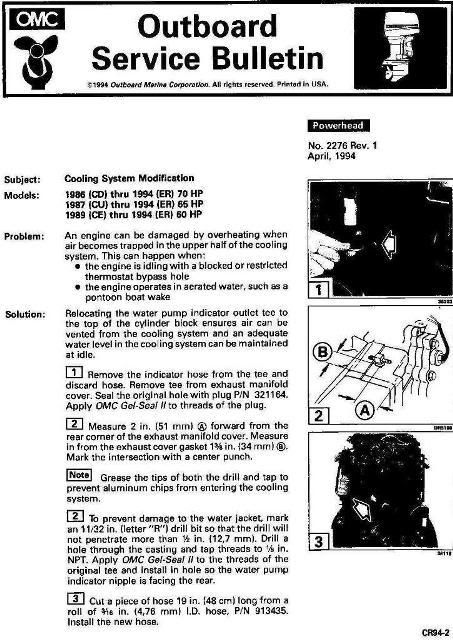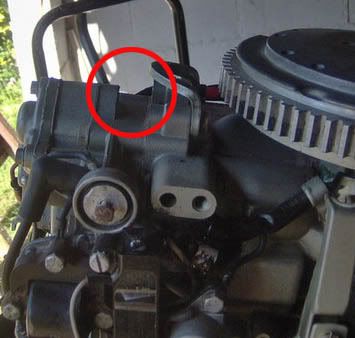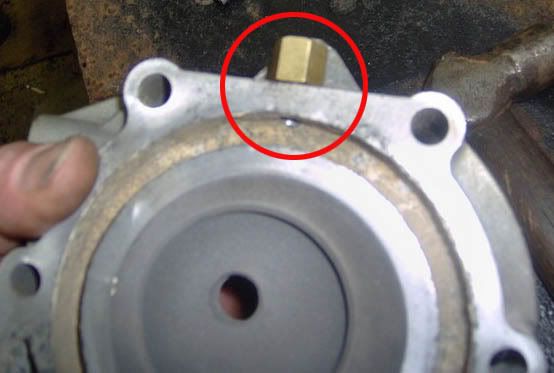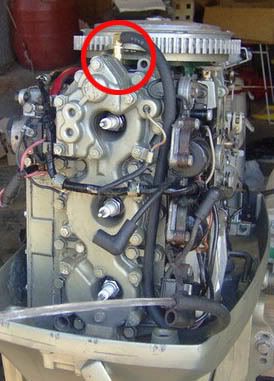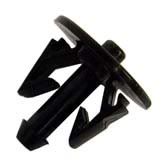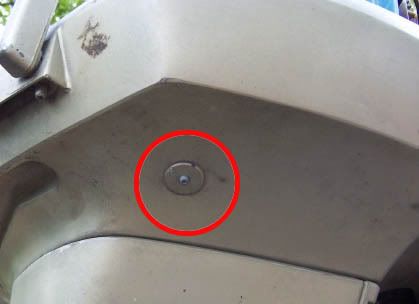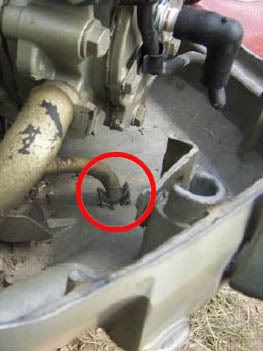iwombat
Captain
- Joined
- Jul 12, 2006
- Messages
- 3,767
[size=+2]Adding a water pressure indicator to an OMC outboard.[/size]
Tell-tale, tale-tell, that little squirty thing -- later model OMCs have 'em and you want one on yours.
The water pump is a crucial element in preserving the health of your outboard. It's vitally important to know that it's functioning properly. That's where the water pressure indicator comes in. It functions by tapping into the water-jacket in your powerhead and providing a visible relief outlet, or "pee stream". The outlet is small, and has limited flow so water pressure is still maintained in the powerhead and doesn't all escape via the indicator.
To retrofit the indicator, you'll need to tap a hole for a fitting in your powerhead's water jacket, put a hole in your lower cowling for a bulkhead indicator fitting and run a hose between the two.
If you have an early 80s or late 70s motor, it may be adviseable to relocate, or modify the routing of the indicator's plumbing. Service bulletins have been included in the appropriate engine section where available. Included is a section on modifications at the end of the FAQ to cover some of these procedures.
[size=+1]Adding the indicator outlet to the block[/size]
OMC's early tell-tale equiped motors tapped into the bottom of the water jacket through the exhaust cover for the indicator's source. It was later realized that tapping in high up on the powerhead had the added benefit of removing any air-pockets in the cooling system, as well as draining the entire system after use. The latter has substantial benefit for winter storage in cold climes. Most later model OMCs had their tell-tale outlets located high up on the exhaust cover for these reasons.
In retro-fitting a tell-tale, you have many choices for locating the indicator outlet on the block. Certainly, the exhaust cover is one, but on some blocks there are better choices. Wherever you choose to locate it, higher is better.
At the chosen location you'll need to drill an 11/32" hole and tap it with a 1/8" pipe tap. This will accept either the OEM outlet elbow (P#321886 0r Sierra # 18-3290). All of these accept a 3/16" to 5/16" ID hose (P# 321887, 913435, or 327721) that will run to a bulk-head fitting (P# 0321885) through the lower cowling. When drilling the hole, apply grease to the drill bit to capture any metal shavings, and be sure to use a light oil on the tap so the threads are cut properly.
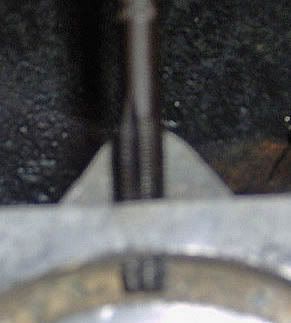
The tap goes through the outer wall and into the water jacket.
[size=+1]V-4 blocks[/size]
The V-4 configuration presents some interesting issues for locating the indicator outlet. Typically the V-4s run hot on the starboard side. That's because of a tendency to develop air pockets high up on cylinder #1. By adding the indicator outlet to the top of the water jacket above cylinder #1 you provide an opportunity to "burp" any air out of the system and fix this issue. On many of the '73-'77 V-4 blocks there's a cast-in round boss just perfect for locating the indicator outlet. If you don't happen to have that boss, you can go in through the top, just behind the coil brackets also.
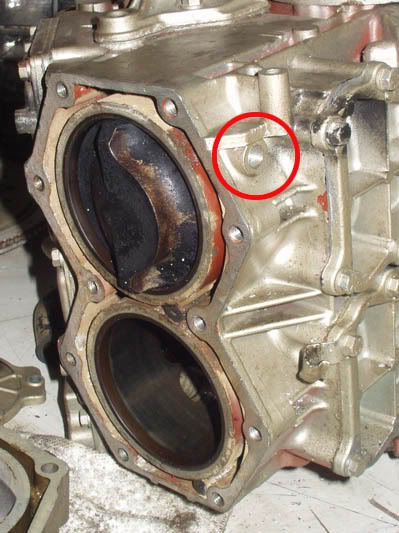
Location of the cast-in boss w/ hole tapped.
This location puts the outlet at a high spot in the cooling jacket. Also, since it's to the side of the block, it's easier to route to the side of cowling for the bulkhead fitting than an outlet located on the exhaust cover.
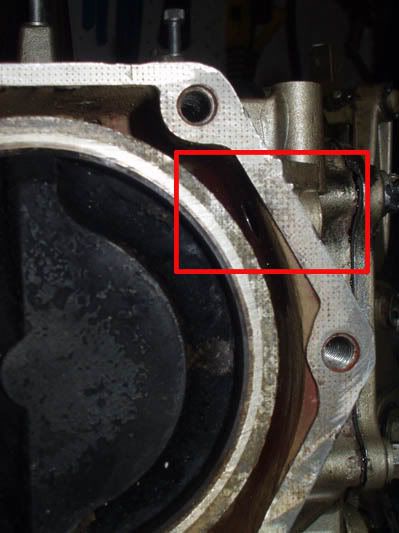
Using the boss provides access high up on cylinder #1's water jacket.
Tell-tale, tale-tell, that little squirty thing -- later model OMCs have 'em and you want one on yours.
The water pump is a crucial element in preserving the health of your outboard. It's vitally important to know that it's functioning properly. That's where the water pressure indicator comes in. It functions by tapping into the water-jacket in your powerhead and providing a visible relief outlet, or "pee stream". The outlet is small, and has limited flow so water pressure is still maintained in the powerhead and doesn't all escape via the indicator.
To retrofit the indicator, you'll need to tap a hole for a fitting in your powerhead's water jacket, put a hole in your lower cowling for a bulkhead indicator fitting and run a hose between the two.
If you have an early 80s or late 70s motor, it may be adviseable to relocate, or modify the routing of the indicator's plumbing. Service bulletins have been included in the appropriate engine section where available. Included is a section on modifications at the end of the FAQ to cover some of these procedures.
[size=+1]Adding the indicator outlet to the block[/size]
OMC's early tell-tale equiped motors tapped into the bottom of the water jacket through the exhaust cover for the indicator's source. It was later realized that tapping in high up on the powerhead had the added benefit of removing any air-pockets in the cooling system, as well as draining the entire system after use. The latter has substantial benefit for winter storage in cold climes. Most later model OMCs had their tell-tale outlets located high up on the exhaust cover for these reasons.
In retro-fitting a tell-tale, you have many choices for locating the indicator outlet on the block. Certainly, the exhaust cover is one, but on some blocks there are better choices. Wherever you choose to locate it, higher is better.
At the chosen location you'll need to drill an 11/32" hole and tap it with a 1/8" pipe tap. This will accept either the OEM outlet elbow (P#321886 0r Sierra # 18-3290). All of these accept a 3/16" to 5/16" ID hose (P# 321887, 913435, or 327721) that will run to a bulk-head fitting (P# 0321885) through the lower cowling. When drilling the hole, apply grease to the drill bit to capture any metal shavings, and be sure to use a light oil on the tap so the threads are cut properly.

The tap goes through the outer wall and into the water jacket.
[size=+1]V-4 blocks[/size]
The V-4 configuration presents some interesting issues for locating the indicator outlet. Typically the V-4s run hot on the starboard side. That's because of a tendency to develop air pockets high up on cylinder #1. By adding the indicator outlet to the top of the water jacket above cylinder #1 you provide an opportunity to "burp" any air out of the system and fix this issue. On many of the '73-'77 V-4 blocks there's a cast-in round boss just perfect for locating the indicator outlet. If you don't happen to have that boss, you can go in through the top, just behind the coil brackets also.

Location of the cast-in boss w/ hole tapped.
This location puts the outlet at a high spot in the cooling jacket. Also, since it's to the side of the block, it's easier to route to the side of cowling for the bulkhead fitting than an outlet located on the exhaust cover.

Using the boss provides access high up on cylinder #1's water jacket.
Last edited by a moderator:




















